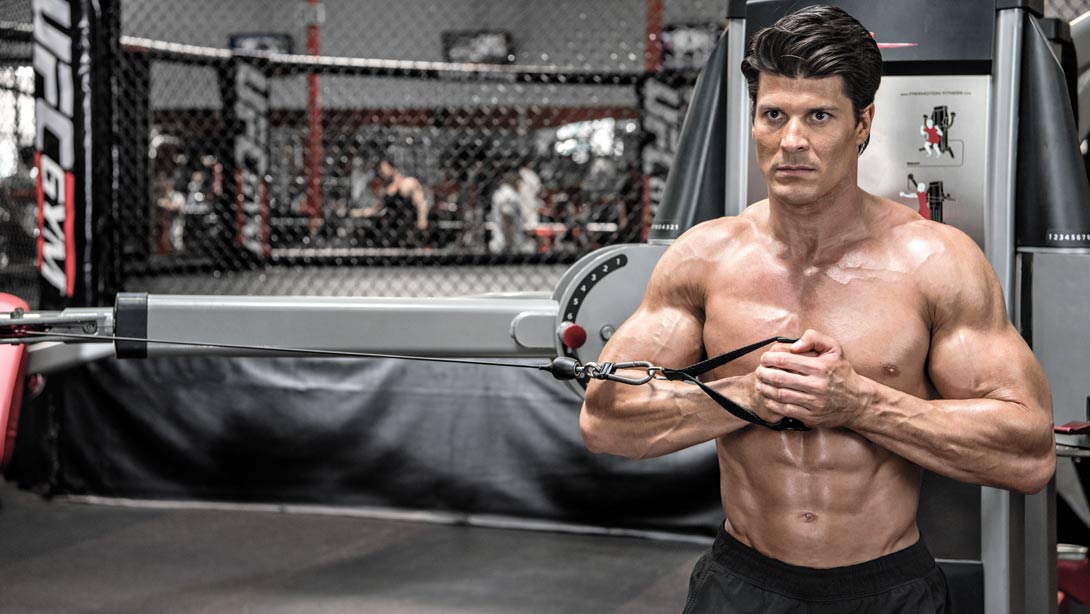28-Days-to-Lean Meal Plan
With the right plan and the right discipline, you can get seriously shredded in just 28 days.
Read article
In 2006, ophysical therapist John Pallof showed Eric Cressey and Tony Gentilcore the belly press (now the Pallof Press) when they were both getting Cressey Performance off the ground. And just like that, the Pallof press as you know it was born.
The Pallof press, no matter the variation, trains anti-rotation, anti-lumbar extension, and posterior pelvic tilt, simulating forces that occur during squats and deadlifts and in daily life also.
This is a fantastic exercise that covers a lot of bases and deserves a place in your training. Here we will explain:
The Pallof press is an anti-rotation exercise that trains the larger and smaller muscles around the spine to resist rotation. This exercise has you hold a resistance band or cable in front of your torso while pressing it out and back. This tension pulls you toward the anchor point and your core resists to keep your torso front on.
Since your lower back is not designed for rotation, this is a great exercise to resist the forces placed on the spine by exercises such as squats and deadlifts. Plus, it’s great if you’re paid to play because it builds the required core strength to cope with changes of directions and throwing or hitting with power without getting hurt.
Although this movement trains the muscles that resist rotation, it trains multiple important upper- and lower-body muscles.
There are always forces happening on your spine whether you’re lifting or playing. The better you can resist these forces, the better you will move and the more weight you will lift. Resisting outside forces is one of few important benefits it provides. And here are a few more.
The Pallof press seems simple enough. You press the band out and in for a few reps and then crush your deadlifts, correct? Yes, it is simple but there are three important points to keep in mind:
Below are three ways to program the Pallof press into your training, allowing you the flexibility to use them where they benefit you the most.
1A. Pallof press: 12 reps (each side)
1B. Farmer’s carry: 40 yards
1C. Ab-wheel rollout: 8-12 reps
The key with the Pallof press is to prime the body for the work ahead and not exhaust it. Anywhere from one to three sets using a rep range of between eight to 15 reps works well.
This exercise is not a strength exercise but an exercise to challenge and strengthen the core. So, start with a resistance you can comfortably handle with good form and when this feels easy then use more resistance or more reps.
The Pallof press is a versatile exercise where changing your body position and changing the angle of the pull helps improve hip mobility, core stability, and reinforces good technique with exercises such as squats, deadlifts, and overhead presses. Here are three examples.
Two factors for effective deadlifting are full-body tension and hip mobility. When you think of hip mobility, the glutes and the hip flexors get most of the love and the adductors are often forgotten about. But the adductors play a vital role in flexing/extending the hip and if they’re “tight” then getting adequate hip flexion and extension to dominate the deadlift becomes a problem.
The split-stance Pallof press will give your adductors an active stretch, fire up your glutes, turns on the muscles responsible for spinal stability. All this makes it a great exercise to pair with squats and deadlifts.
The half kneeling position with its narrow base of support increases the demand of the core and hip stabilizers. And pairing this with the Pallof press adds to this because the stabilizers must fight the added rotational forces. The half kneeling position needs good hip flexion, hip extension, and core stability to do well and the Pallof press makes this better.
Improving core stability and hip mobility is a sure way to squat and deadlift safely with good technique.
When you’re cranking out the last rep or two on the overhead press, two things usually happen. The lower back arches heavily and lower rib cage starts protruding. This is not great because compromising technique for ego and gains may lead to injury. Avoid this by grooving the overhead pattern with the tall kneeling overhead Pallof press.
For both exercises to be performed well you will need to:
It makes perfect sense to pair these exercises together to improve overhead pressing form while protecting your lower back.